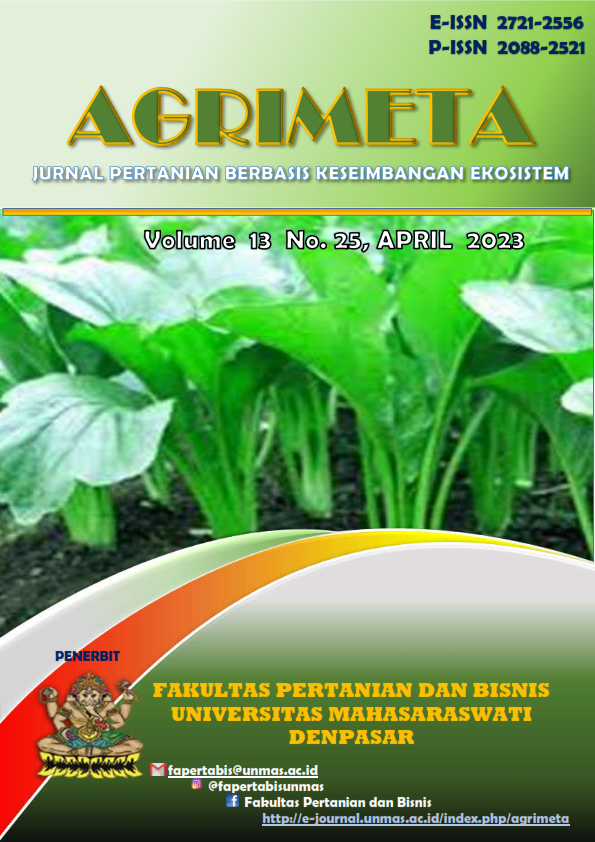KORELASI PADA KARAKTER KOMPONEN HASIL TERHADAP HASIL KONSUMSI GALUR TANAMAN SAWI (Brassica juncea L.)
Keywords:
mustrad, yield component, correlationAbstract
Mustard is a type of horticultural vegetable that has nutrients and vitamins that are good for the body. Given the price of mustard which is quite economical in the community, many people consume these vegetables. The success of the effort to obtain mustard that have good quality and quantity of yield greatly supported by ability of plant breeders to obtain superior genotypes in selection stage. This research aims to find out correlation between yield components and yield on mustard. The next goal to find out character of yield components that have direct effect on the yield of mustard and can be used as basis for effective selection. The research was conducted in December 2018-March 2019 at Seed Bank and Nursery Agrotechno Park, BUA Universitas Brawijaya, located in Jatikerto Village, Kromengan District, Malang Regency, East Java Province. This research uses materials of 60 genotypes of mustard plants (Brassica juncea L.). The research method used randomized group design (RBD) expanded (augmented design). The treatments in study were arranged into 5 blocks and there were 60 experimental units each consisting of 7 plants. This research uses analysis of variance, covariance, and correlation with OPSTAT applications. The results of research showed that components of consumption yield were highly significantly correlated, including of leaf number, stem diameter, plant height and wet weight of harvest consumption weights. Plant height, stem diameter and wet weight can be used as an effective selection basis to decide consumption yield on mustard.
Downloads
References
Adikardasih, S., S. Permata, Taryono, Suyadi, P. Basunanda. 2015.Hubungan Antara Hasil dan Hasil Komponen Hasil Wijen (Sesanum indicum L.) pada Generasi F1 dan F2 Persilangan Sbr2, Sbr3, Dt36. Buletin Tanaman Tembakau, Serat & Minyak Industri. 7(1):45-51.
Ali, F., J. Khan, H. Raza, I. Naeem, M. Khan, N. N. Khan, A. Rashid, M. W. Khan, J.Ali And A. S. Khan. 2017. Genetic variability and correlation studi.
Arikunto, S. 2013. Prosedur Penelitian : Suatu Pendekatan Praktik. Rineka Cipta. Jakarta. pp. 313 – 319.
BPS. 2018. Produksi Sayuran dan Buah-Buahan Di Jawa Timur Tahun 2008 – 2016. Badan Pusat Statistik Provinsi Jawa Timur.
Istarofah dan Z. Salamah. 2017. Pertumbuhan tanaman sawi hijau (Brassica juncea L.) dengan pemberian kompos berbahan dasar daun paitan (Thitonia diversifolia). Bio-site. 1 (03) : 39 – 46.
Kumar R, S. S. Gauvar, S. Jayasudha, and H. Kumar. 2015. Study of correlation and path coefficient analysis in germplasm lines of Indian mustard (Brasica juncea L.). Agric. Sci. Digest., 36 (2) 2016: 92-96.
Kumar A, M. Singh, R. K. Yadav, P. Singh, and Lallu. 2017. Study of correlation and path coefficient among the characters of Indian mustard. Hte Pharma Innovation 7 (1) : 412-416.
Kuntoro, H. 2011. Metode Statistik Edisi Revisi. Pustaka Melati. Surabaya. pp. 71 – 74.
Mekonnen, T.W., A. Wakjira, and T. Genet. 2014. Correlation and path coefficient analysis among yield component traits of Ethiopian Indian mustard ( Brassica carinata a . brun ) at Adet , northwestern , Ethiopia. 2 (2) : 89–96.
Prasad, G dan B.R. Patil. 2018. Association and path coefficient analysis in Indian mustard genotypes. International Journal of Chemical Studies 6(5): 362-368.
Roy, R. K., A. Kumar, S. Kumar, A Kumar, R. R. Kumar. 2018. Correlation and path analysis in Indian Mustard (Brassica juncea L. Czern and Coss) under late sown condition. Enviroment and ecology 36 (IA) : 247-254.
Sharma, J. R. 2006. Statistical and Biometrical Techniques in Plant Breeding. New Age International Publishers. Lucknow. pp. 24 – 32.
Sheoran, O.P; Tonk, D.S; Kaushik, L.S; Hasija, R.C dan Pannu, R.S. 1998. Statistical Software Package for Agricultural Research Workers. Recent Advances in information theory, Statistics & Computer Applications by D.S. Hooda & R.C. Hasija Department of Mathematics Statistics, CCS HAU, Hisar (139-143).
Tuncturk, M., dan V. Ciftci. 2007. Relationships between yield and some yield components in rapeseed ( Brassica napus ssp .
Ul-Hasan, E., H.S.B. Mustafa, T. Bibi, and T. Mahmood. 2014. Genetic variability, correlation and path analysis in advanced lines of rapeseed (Brassica napus L.) for yield components. Cercet. Agron. Mold. 47 (1) : 71 – 79.
UPOV (International Union For The Protection Of New Varieties Of Plants). 2016. Draf Brown Mustrad (Brassica juncea. L.). Japan. pp. 1- 35.
USDA. 2012. Nutrient Data For 11270, Indian mustard Greens, Raw. (http://ndb.nal.usda.gov/ndb/foods/show/3003) [23 September 2012]






